Abstract
The National Institutes of Health/Department of Energy Human Genome Project has been funding directed research for only 5 years, and it is understandably difficult to cite important research advances directly attributable to the project. However, the project has been constructive in fostering multidisciplinary group research and an inspiring and synergistic "just do it" attitude in both political and scientific circles, domestically and abroad. This collaborative spirit has spawned large-scale genetic and physical mapping projects, with the most impressive and useful results to date being the dense genetic maps produced by the Généthon, a French organization largely supported by the French muscular dystrophy association. With the genetic and physical map reagents now becoming available, disease-gene cloning is proceeding at an increasingly rapid pace. More important than the predictable acceleration of disease-gene mapping are the unpredictable benefits: Will a dense PCR-based dinucleotide-repeat genetic map open novel alternative approaches to disease-gene isolation? Will it become possible to localize disease genes by simply analyzing unrelated, isolated probands rather than the rarer "extended family"? Proband-based "linkage-disequilibrium cloning" may become possible if adequate density, informativeness, and stability of polymorphic loci are obtained. In addition, "genome exclusion cloning" will be added to the established positional, candidate-gene, and functional-disease-gene-cloning experimental approaches. The anticipated exponential expansion of human genetic disease information over the remainder of the 10-year tenure of the Human Genome Project unveils critical yet unresolved issues for medical education and the practice of medicine.(ABSTRACT TRUNCATED AT 250 WORDS)
Full text
PDF
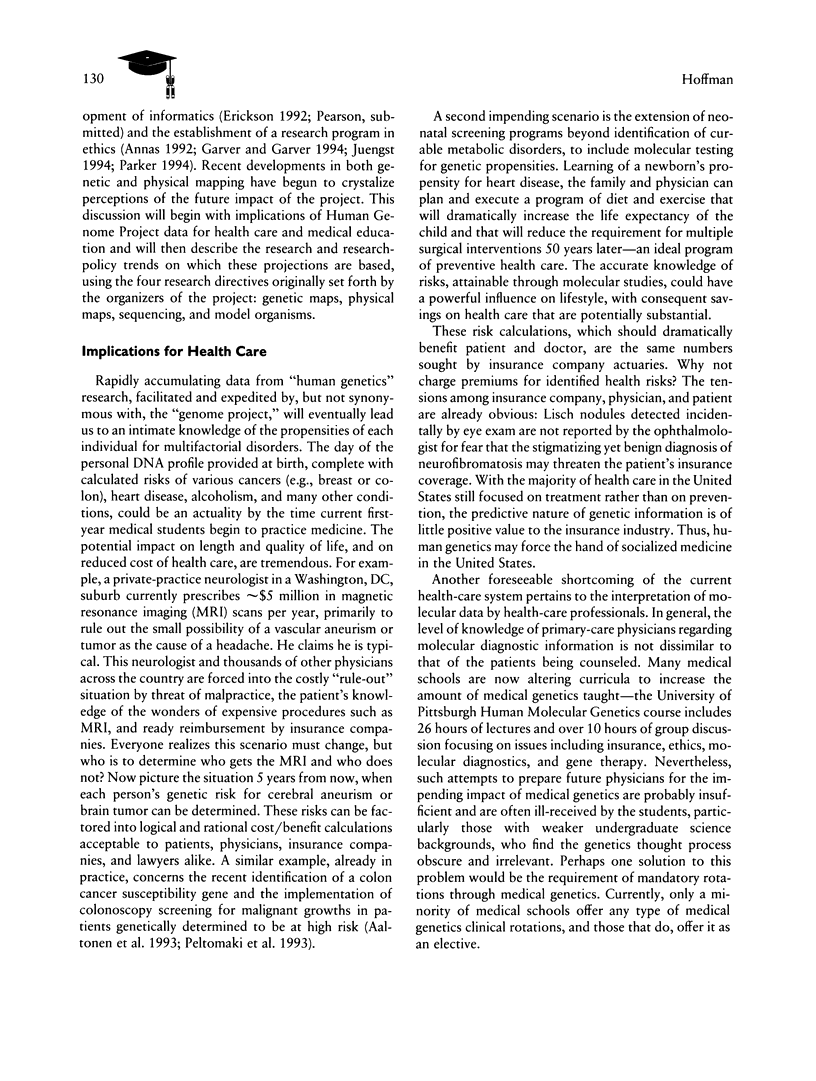
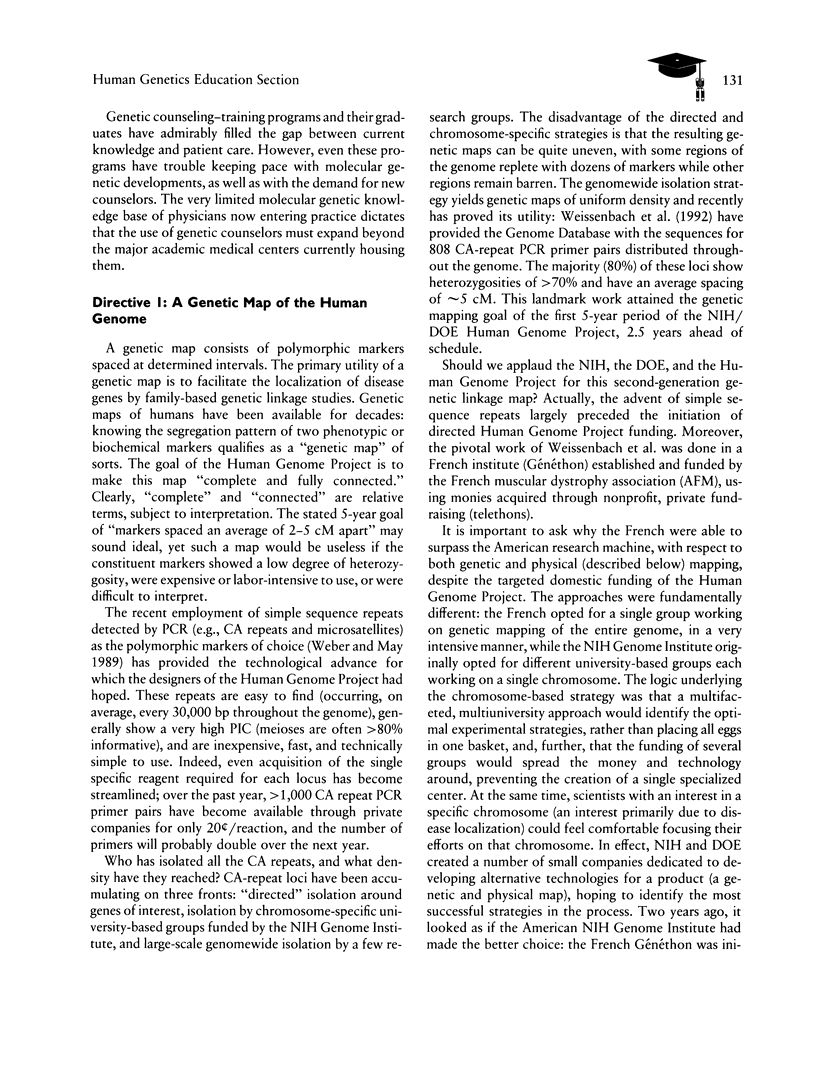
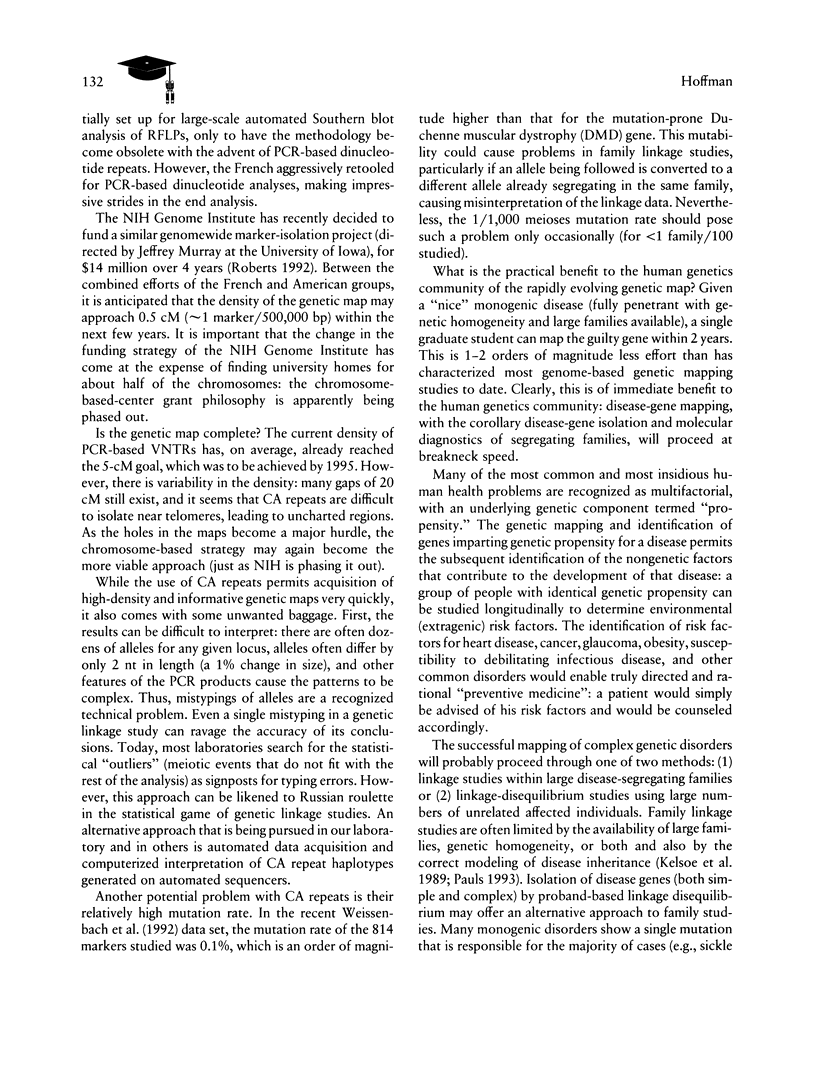
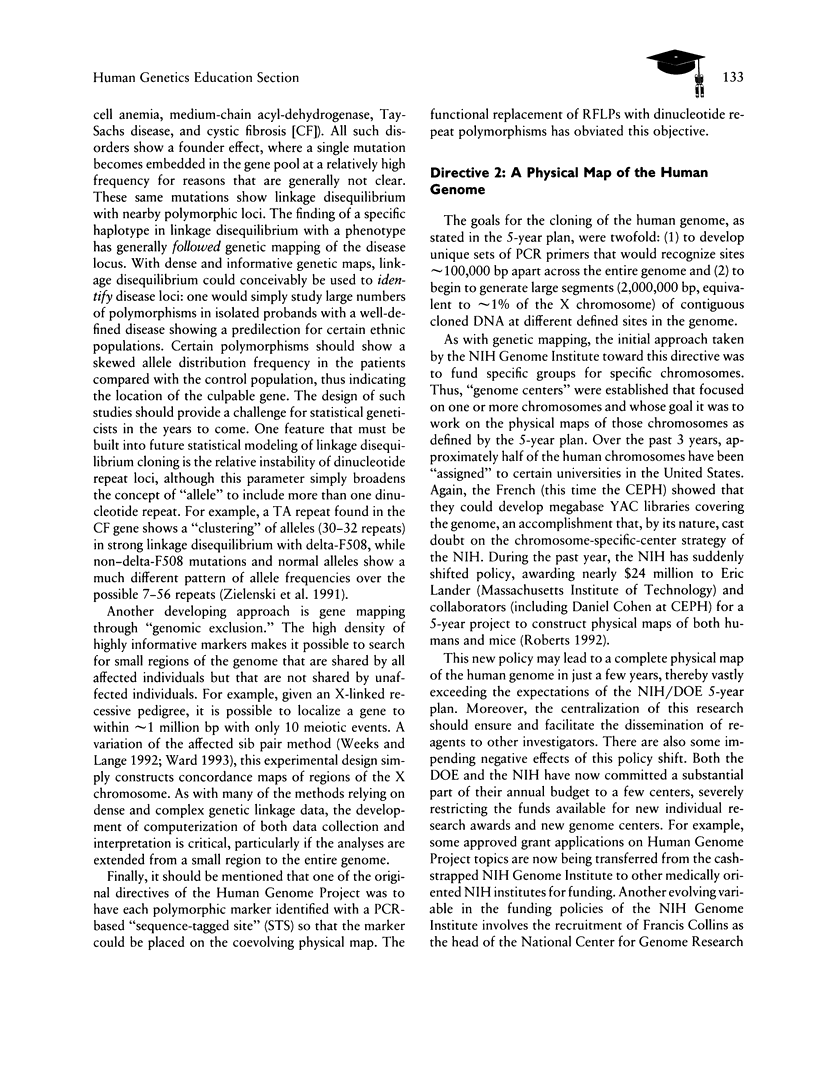

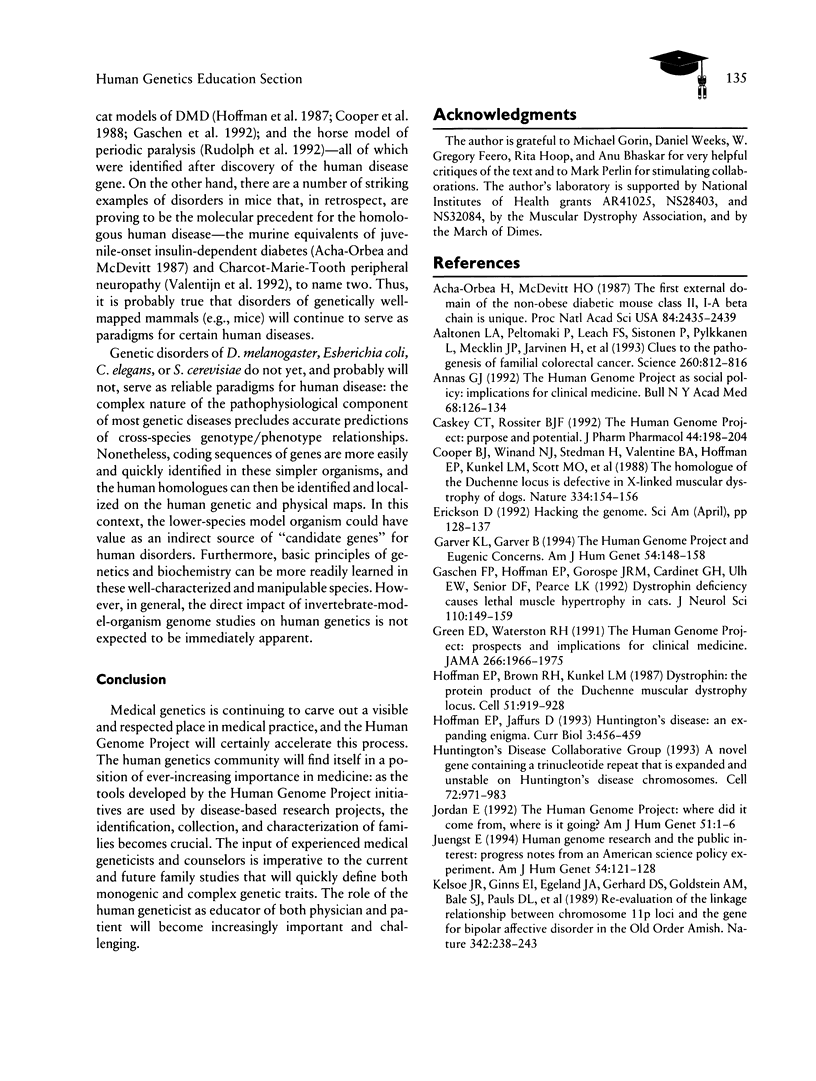
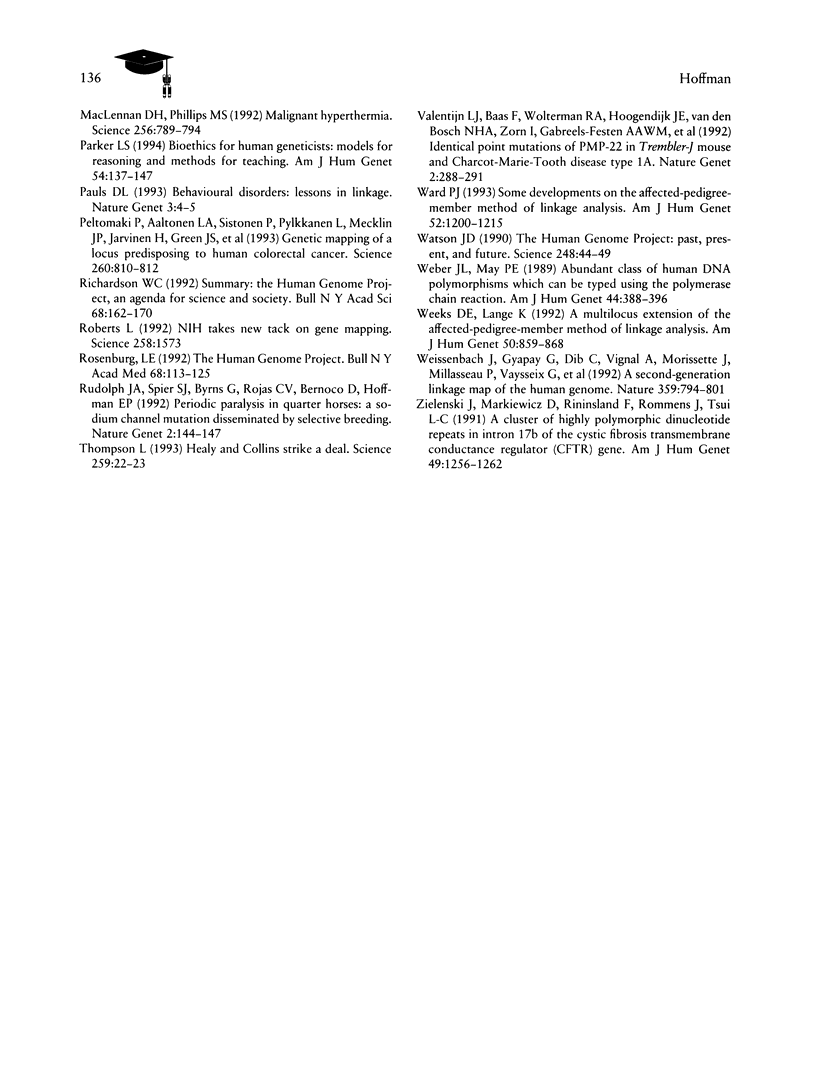
Selected References
These references are in PubMed. This may not be the complete list of references from this article.
- Aaltonen L. A., Peltomäki P., Leach F. S., Sistonen P., Pylkkänen L., Mecklin J. P., Järvinen H., Powell S. M., Jen J., Hamilton S. R. Clues to the pathogenesis of familial colorectal cancer. Science. 1993 May 7;260(5109):812–816. doi: 10.1126/science.8484121. [DOI] [PubMed] [Google Scholar]
- Acha-Orbea H., McDevitt H. O. The first external domain of the nonobese diabetic mouse class II I-A beta chain is unique. Proc Natl Acad Sci U S A. 1987 Apr;84(8):2435–2439. doi: 10.1073/pnas.84.8.2435. [DOI] [PMC free article] [PubMed] [Google Scholar]
- Annas G. J. The human genome project as social policy: implications for clinical medicine. Bull N Y Acad Med. 1992 Jan-Feb;68(1):126–134. [PMC free article] [PubMed] [Google Scholar]
- Caskey C. T., Rossiter B. J. The human genome project. Purpose and potential. J Pharm Pharmacol. 1992 Feb;44 (Suppl 1):198–204. [PubMed] [Google Scholar]
- Cooper B. J., Winand N. J., Stedman H., Valentine B. A., Hoffman E. P., Kunkel L. M., Scott M. O., Fischbeck K. H., Kornegay J. N., Avery R. J. The homologue of the Duchenne locus is defective in X-linked muscular dystrophy of dogs. Nature. 1988 Jul 14;334(6178):154–156. doi: 10.1038/334154a0. [DOI] [PubMed] [Google Scholar]
- Erickson D. Hacking the genome. Sci Am. 1992 Apr;266(4):128-33, 136-7. doi: 10.1038/scientificamerican0492-128. [DOI] [PubMed] [Google Scholar]
- Garver K. L., Garver B. The Human Genome Project and eugenic concerns. Am J Hum Genet. 1994 Jan;54(1):148–158. [PMC free article] [PubMed] [Google Scholar]
- Gaschen F. P., Hoffman E. P., Gorospe J. R., Uhl E. W., Senior D. F., Cardinet G. H., 3rd, Pearce L. K. Dystrophin deficiency causes lethal muscle hypertrophy in cats. J Neurol Sci. 1992 Jul;110(1-2):149–159. doi: 10.1016/0022-510x(92)90022-d. [DOI] [PubMed] [Google Scholar]
- Green E. D., Waterston R. H. The human genome project. Prospects and implications for clinical medicine. JAMA. 1991 Oct 9;266(14):1966–1975. [PubMed] [Google Scholar]
- Hoffman E. P., Brown R. H., Jr, Kunkel L. M. Dystrophin: the protein product of the Duchenne muscular dystrophy locus. Cell. 1987 Dec 24;51(6):919–928. doi: 10.1016/0092-8674(87)90579-4. [DOI] [PubMed] [Google Scholar]
- Hoffman E. P., Jaffurs D. An expanding enigma. Curr Biol. 1993 Jul 1;3(7):456–459. doi: 10.1016/0960-9822(93)90356-s. [DOI] [PubMed] [Google Scholar]
- Jordan E. The Human Genome Project: where did it come from, where is it going? Am J Hum Genet. 1992 Jul;51(1):1–6. [PMC free article] [PubMed] [Google Scholar]
- Juengst E. T. Human genome research and the public interest: progress notes from an American science policy experiment. Am J Hum Genet. 1994 Jan;54(1):121–128. [PMC free article] [PubMed] [Google Scholar]
- Kelsoe J. R., Ginns E. I., Egeland J. A., Gerhard D. S., Goldstein A. M., Bale S. J., Pauls D. L., Long R. T., Kidd K. K., Conte G. Re-evaluation of the linkage relationship between chromosome 11p loci and the gene for bipolar affective disorder in the Old Order Amish. Nature. 1989 Nov 16;342(6247):238–243. doi: 10.1038/342238a0. [DOI] [PubMed] [Google Scholar]
- MacLennan D. H., Phillips M. S. Malignant hyperthermia. Science. 1992 May 8;256(5058):789–794. doi: 10.1126/science.1589759. [DOI] [PubMed] [Google Scholar]
- Parker L. S. Bioethics for human geneticists: models for reasoning and methods for teaching. Am J Hum Genet. 1994 Jan;54(1):137–147. [PMC free article] [PubMed] [Google Scholar]
- Pauls D. L. Behavioural disorders: lessons in linkage. Nat Genet. 1993 Jan;3(1):4–5. doi: 10.1038/ng0193-4. [DOI] [PubMed] [Google Scholar]
- Peltomäki P., Aaltonen L. A., Sistonen P., Pylkkänen L., Mecklin J. P., Järvinen H., Green J. S., Jass J. R., Weber J. L., Leach F. S. Genetic mapping of a locus predisposing to human colorectal cancer. Science. 1993 May 7;260(5109):810–812. doi: 10.1126/science.8484120. [DOI] [PubMed] [Google Scholar]
- Richardson W. C. Summary: The Human Genome Project, an agenda for science and society. Bull N Y Acad Med. 1992 Jan-Feb;68(1):162–170. [PMC free article] [PubMed] [Google Scholar]
- Roberts L. NIH takes new tack on gene mapping. Science. 1992 Dec 4;258(5088):1573–1573. doi: 10.1126/science.1455244. [DOI] [PubMed] [Google Scholar]
- Rosenberg L. E. The human genome project. Bull N Y Acad Med. 1992 Jan-Feb;68(1):113–114. [PMC free article] [PubMed] [Google Scholar]
- Rudolph J. A., Spier S. J., Byrns G., Rojas C. V., Bernoco D., Hoffman E. P. Periodic paralysis in quarter horses: a sodium channel mutation disseminated by selective breeding. Nat Genet. 1992 Oct;2(2):144–147. doi: 10.1038/ng1092-144. [DOI] [PubMed] [Google Scholar]
- Thompson L. Human genome program. Healy and Collins strike a deal. Science. 1993 Jan 1;259(5091):22–23. [PubMed] [Google Scholar]
- Valentijn L. J., Baas F., Wolterman R. A., Hoogendijk J. E., van den Bosch N. H., Zorn I., Gabreëls-Festen A. W., de Visser M., Bolhuis P. A. Identical point mutations of PMP-22 in Trembler-J mouse and Charcot-Marie-Tooth disease type 1A. Nat Genet. 1992 Dec;2(4):288–291. doi: 10.1038/ng1292-288. [DOI] [PubMed] [Google Scholar]
- Ward P. J. Some developments on the affected-pedigree-member method of linkage analysis. Am J Hum Genet. 1993 Jun;52(6):1200–1215. [PMC free article] [PubMed] [Google Scholar]
- Watson J. D. The human genome project: past, present, and future. Science. 1990 Apr 6;248(4951):44–49. doi: 10.1126/science.2181665. [DOI] [PubMed] [Google Scholar]
- Weber J. L., May P. E. Abundant class of human DNA polymorphisms which can be typed using the polymerase chain reaction. Am J Hum Genet. 1989 Mar;44(3):388–396. [PMC free article] [PubMed] [Google Scholar]
- Weeks D. E., Lange K. A multilocus extension of the affected-pedigree-member method of linkage analysis. Am J Hum Genet. 1992 Apr;50(4):859–868. [PMC free article] [PubMed] [Google Scholar]
- Weissenbach J., Gyapay G., Dib C., Vignal A., Morissette J., Millasseau P., Vaysseix G., Lathrop M. A second-generation linkage map of the human genome. Nature. 1992 Oct 29;359(6398):794–801. doi: 10.1038/359794a0. [DOI] [PubMed] [Google Scholar]
- Zielenski J., Markiewicz D., Rininsland F., Rommens J., Tsui L. C. A cluster of highly polymorphic dinucleotide repeats in intron 17b of the cystic fibrosis transmembrane conductance regulator (CFTR) gene. Am J Hum Genet. 1991 Dec;49(6):1256–1262. [PMC free article] [PubMed] [Google Scholar]


